Aquarium Update - Freshwater Goby
Here are a few pictures of our aquarium and its inhabitants. It's coming up to about a year and a half since the start of this aquatic world and things are going along fine with only a few minor problems. I am still fine tuning the growth of various species of plants before I make the final 'aquascape' design, maybe next year if I can find plants that grow together well and look interesting at the same time. Right now, although there is no aquascape, the tank is still nice to look at: a bright and green island of tropical jungle in our (otherwise) unheated living room.
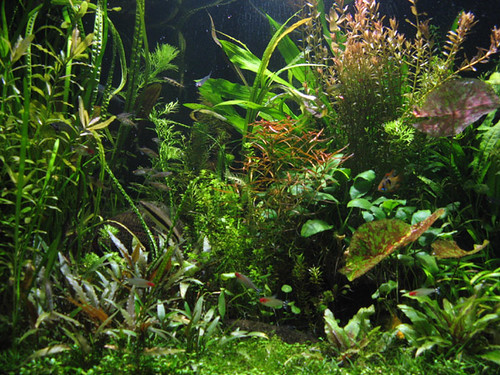
これで、数枚の水槽の画像を入れます。始まったからもう一年半たっている。まだまだ、いろんな小さい問題があるけど、大体の魚達も水草も元気で進んでいる。多分来年レイアウト水槽にするけど、まだまだ水草の種類の合わせ方について調査をしています。現在、レイアウトは無いのに、冬の寒さの間、暖房やストーブが付いてない我が家でこの小さい熱帯の世界をよく楽しんでいます。
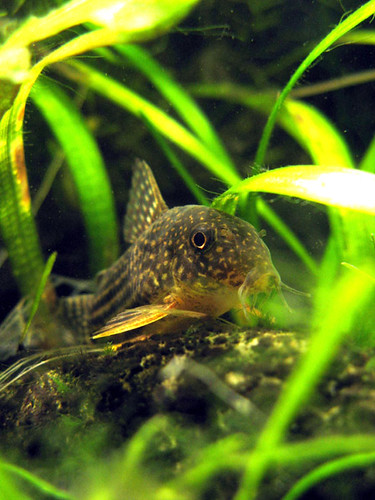
One of our five Corydoras sterbai catfish takes a break from foraging along the tank's bottom. Its mouth is clearly well adapted for finding a morsel among the gravel pebbles.
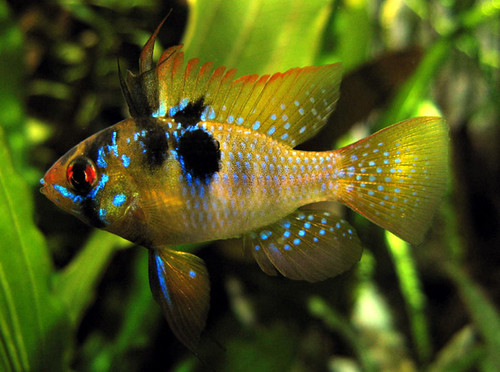
This is the male of a pair of Papiliochromis ramirezi South American cichlids. Besides displaying bright colors, this fish is also the tank's most intelligent, reacting to our presence more than the other fish do.
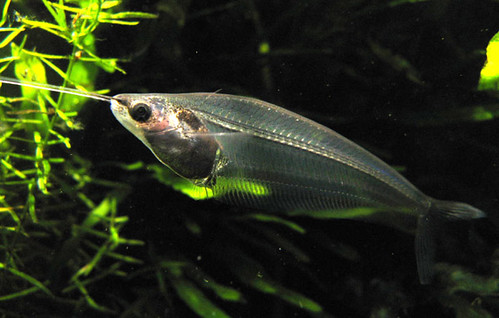
A few months ago we added six transparent 'glass catfish', Kryptopterus bicirrhis. Visitors to our house are always surprised by this strange see-through fish. They are often secretive, hiding in the plants most of the day, but they emerge and become very active around midnight, just before the automatic feeder dispenses food, at which time they go into a feeding frenzy. Interestingly enough, if we remove the timer and feed by hand, they don't exhibit this behavior. Their internal clock seems to be more sensitive than the other fish. この体の透明「ガラスキャット」は、我が家を訪れる人が最も気をつきます。様子も行動も面白い魚で、普段水草の葉っぱの間に身を隠れるけど、餌タイマーが餌をやる時間の30分前外へ出て来て、餌が出るまでタイマーの下で待つ。他の魚より時の知識がよさそう。
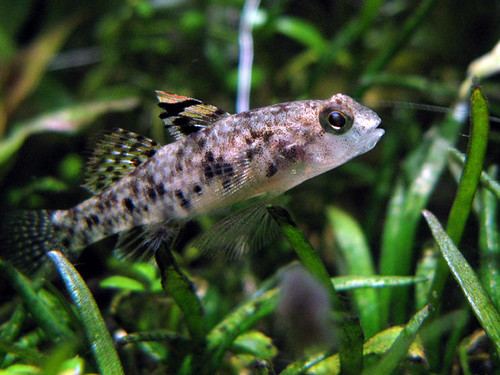
Here is an interesting addition to the tank: a freshwater goby from Ishigaki Island in Okinawa. We brought a few baby fish back from our trip in a 500ml drink bottle, having captured them in a sandy creek estuary. Amazingly, all of them survived the journey; they are now about 5cm in size.
春の沖縄の旅の間、小さい川の河口で手でつかまった五匹くらいの赤ちゃんのハゼみたい魚をコーラの500ミリのペットボトルに入れた。びっくりほどの事で、そのまま天草まで持ってくたとまだまだ生きていた。さっそく水槽にいれました。
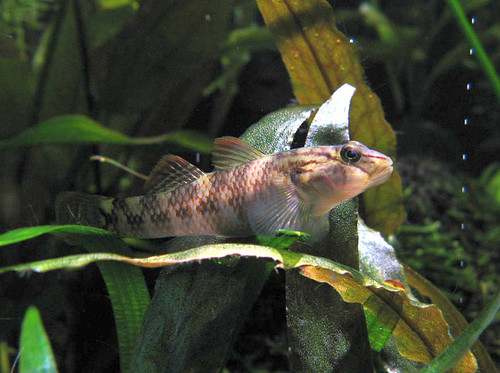
Their curious habits make these gobys interesting aquarium fish. We thought we were on to something, but a quick scan of the Internet shows that there are plenty of goby freaks already out there. Also interesting was the number and variety of colorful species they keep. Our gobies may belong to several species themselves, but we're pretty sure they belong to the genus Rhinogobius. Their particular coloration seems to be unique to Ishigaki Island. ネットに調べると「ヨシノボリ」と言う淡水のハゼの仲間です。(ハゼのいろんな種類を飼っている人もいる事でかなり驚いた。)行動の面白い魚なのでかなり好きになっている。
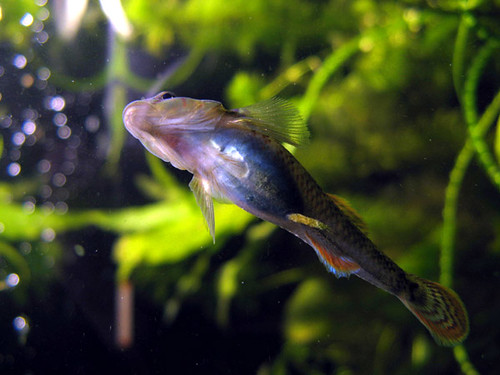
A little to either side of the abdomen the goby has a suction cup-like device with which it can adhere to the glass of the aquarium, as this one is doing. ヨシノボリは、おなかのところキスゴムみたいやつがあり、植物、石、水槽のガラスなどにくっ付く事が出来る。
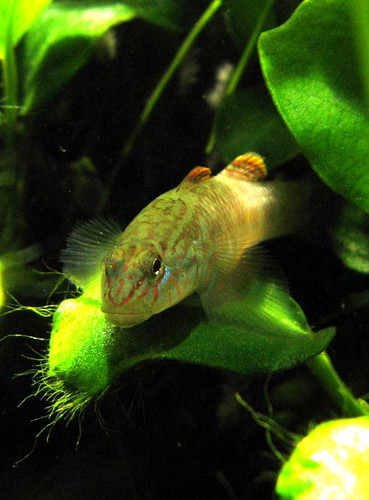

これで、数枚の水槽の画像を入れます。始まったからもう一年半たっている。まだまだ、いろんな小さい問題があるけど、大体の魚達も水草も元気で進んでいる。多分来年レイアウト水槽にするけど、まだまだ水草の種類の合わせ方について調査をしています。現在、レイアウトは無いのに、冬の寒さの間、暖房やストーブが付いてない我が家でこの小さい熱帯の世界をよく楽しんでいます。

One of our five Corydoras sterbai catfish takes a break from foraging along the tank's bottom. Its mouth is clearly well adapted for finding a morsel among the gravel pebbles.

This is the male of a pair of Papiliochromis ramirezi South American cichlids. Besides displaying bright colors, this fish is also the tank's most intelligent, reacting to our presence more than the other fish do.

A few months ago we added six transparent 'glass catfish', Kryptopterus bicirrhis. Visitors to our house are always surprised by this strange see-through fish. They are often secretive, hiding in the plants most of the day, but they emerge and become very active around midnight, just before the automatic feeder dispenses food, at which time they go into a feeding frenzy. Interestingly enough, if we remove the timer and feed by hand, they don't exhibit this behavior. Their internal clock seems to be more sensitive than the other fish. この体の透明「ガラスキャット」は、我が家を訪れる人が最も気をつきます。様子も行動も面白い魚で、普段水草の葉っぱの間に身を隠れるけど、餌タイマーが餌をやる時間の30分前外へ出て来て、餌が出るまでタイマーの下で待つ。他の魚より時の知識がよさそう。

Here is an interesting addition to the tank: a freshwater goby from Ishigaki Island in Okinawa. We brought a few baby fish back from our trip in a 500ml drink bottle, having captured them in a sandy creek estuary. Amazingly, all of them survived the journey; they are now about 5cm in size.
春の沖縄の旅の間、小さい川の河口で手でつかまった五匹くらいの赤ちゃんのハゼみたい魚をコーラの500ミリのペットボトルに入れた。びっくりほどの事で、そのまま天草まで持ってくたとまだまだ生きていた。さっそく水槽にいれました。

Their curious habits make these gobys interesting aquarium fish. We thought we were on to something, but a quick scan of the Internet shows that there are plenty of goby freaks already out there. Also interesting was the number and variety of colorful species they keep. Our gobies may belong to several species themselves, but we're pretty sure they belong to the genus Rhinogobius. Their particular coloration seems to be unique to Ishigaki Island. ネットに調べると「ヨシノボリ」と言う淡水のハゼの仲間です。(ハゼのいろんな種類を飼っている人もいる事でかなり驚いた。)行動の面白い魚なのでかなり好きになっている。

A little to either side of the abdomen the goby has a suction cup-like device with which it can adhere to the glass of the aquarium, as this one is doing. ヨシノボリは、おなかのところキスゴムみたいやつがあり、植物、石、水槽のガラスなどにくっ付く事が出来る。

Labels: aquarium 水槽













